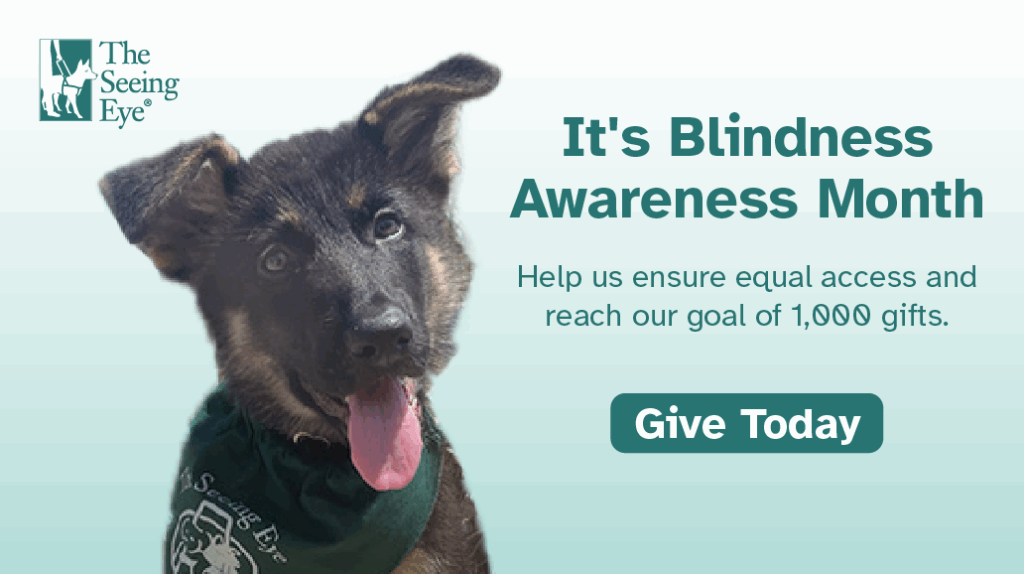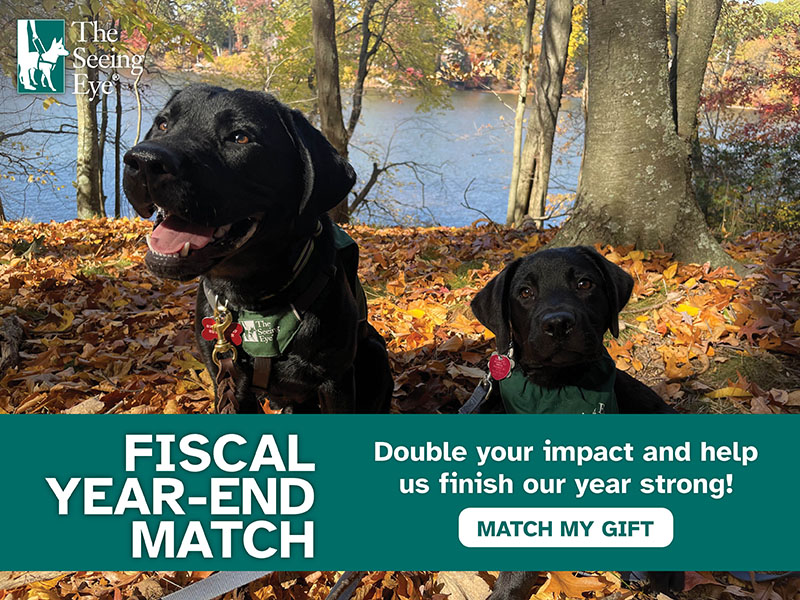Resources
O & M FAQ
Frequently Asked Questions: O&M
What are Seeing Eye® dogs trained to do?
A Seeing Eye dog’s role is to guide their handler safely to a destination, while avoiding obstacles, hazards in the environment, and intelligently disobeying commands that would put the team in danger. Seeing Eye dogs assist their handler in tasks such as safely crossing a street, indicating the handle of a door, stopping for stairs and down curbs, and navigating a path in a busy or chaotic environment. Seeing Eye dogs are off duty when they are at home with their handler and get to relax and play like regular dogs.
How long does it take to train a Seeing Eye dog?
When a Seeing Eye puppy is about 8 weeks old, they are placed in the home of a volunteer puppy raiser who is responsible for teaching the puppy house manners, basic obedience, socialization, and providing a nurturing environment. When the puppy is about 1 year old, they return to The Seeing Eye and for a four-month course of training with a guide dog mobility instructor. When the dog passes this phase, they are matched with applicants and they train together, under the supervision of a guide dog mobility instructor. Learn more about Seeing Eye dog training.
Does my student have to be totally blind to apply for a Seeing Eye dog?
No, but their remaining vision needs to be evaluated to see if they are an appropriate candidate. People with some vision need to be able to resist guiding the dog and must let the dog be responsible for the team’s safety. Each person is evaluated on an individual basis when considering admission.
How do I determine if my student will qualify?
First, let us reassure you that this decision ultimately is between the student and the school.
Questions that you and your student may want to consider:
Do you have a realistic plan of use for a Seeing Eye dog?
You must have an active daily pedestrian routine which would provide independent travel destinations for the dog.
Are you able to make safe street crossing judgements including at traffic light-controlled intersection?
The decision of when to cross the street lies with the blind handler not with the guide dog. The handler must be able to identify parallel traffic.
Do you have the stamina to work a guide dog?
You must have the ability to walk several blocks consecutively at a consistent pace without resting.
Do you have a clean living and working environment conducive to safe and effective use and care of a Seeing Eye dog?
A safe and supportive home and work environment is crucial to the well-being of the dog and the success of the team.
Are you financially prepared to personally accept full responsibility for your guide dog’s care?
The Seeing Eye estimates the cost of food and veterinary care for a Seeing Eye dog to average $2,000 annually.
Is it OK to have a pet dog or cat at home?
Yes. Many of our dogs are raised in households with cats, dogs, and other pets.
What are the Seeing Eye facilities like?
The main campus is about 2 miles from the center of Morristown. Student accommodations are single rooms with private baths. Each room has a double bed, a telephone, Amazon Echo Dot, safe, mini-fridge, and wireless Internet access. There is a fitness center, indoor and outdoor grooming facilities, a free-run area, laundry facilities, a leisure path, student lounges, student library, and outside patio. Learn more about our campus.
What can I tell my student to expect about training?
New students stay on campus for 3-½ weeks; students who are here for their second or subsequent Seeing Eye dog stay for 2-½ weeks. Students arrive on a Monday and spend the first few days getting acquainted with the surroundings and their instructors. Students are matched with their dogs on Wednesday morning. Days begin at 5:30 a.m., breakfast is at 7 a.m., lunch at 12:15 p.m., and dinner at 5:15 p.m. Each student goes on two trips per day; one in the morning, one in the afternoon. There is time in between trips for laundry, relaxing and socializing. Lectures take place after dinner. Instruction begins with short, simple routes in downtown Morristown, progressing to longer, more varied routes. In the last week of class, students have an opportunity to take a trip to New York City.
Are follow-up services available?
The Seeing Eye takes pride and is known for our graduate support. Staff services are always available for telephone consultations as well as visiting graduates in their homes to help refine training techniques or answer any questions that may come up as dog guide users. This follow up support is available throughout the lifetime of the partnership.
Do Seeing Eye graduates own their dogs, or does the school retain ownership?
Following a student’s successful graduation from the training programs required by The Seeing Eye, the graduated student:
- Is granted full ownership rights over his or her Seeing Eye dog, and
- Assumes full responsibility for the obligations and risks associated with ownership of his or her Seeing Eye dog, including the obligation to properly feed, shelter, and care for his or her Seeing Eye dog.
The Seeing Eye retains ownership of the harness and requires that harnesses be returned to the school upon retirement of any Seeing Eye dog.
In the rare instances that The Seeing Eye becomes aware of allegations of abuse after a graduated student has assumed ownership responsibility of his or her Seeing Eye dog, The Seeing Eye contacts the graduated student and may further assess the allegations. In the event that animal abuse or neglect is proven, The Seeing Eye defers to local enforcement authorities, including local humane societies, who generally possess the legal authority to remove the animal from the abusive environment.
If you still have questions, please call our Admissions Department at 973-539-4425 or email admissions@seeingeye.org.










